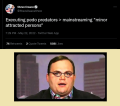One of our staff members is contributing considerably to a News Archiving service at Mu. Any well educated (Masters, PhD or above) users who wish to make comments on news sites, please contact Jim Burton directly rather than using this list, and we can work on maximising view count.
Minor Attracted Person: Difference between revisions
The Admins (talk | contribs) |
m relink to svg |
||
| Line 47: | Line 47: | ||
<gallery> | <gallery> | ||
File:MAPFLAGPNGLARGE.png|2021 variation (Designed on Newgon, intended for wider use) | File:MAPFLAGPNGLARGE.png|2021 variation (Designed on Newgon, intended for wider use) | ||
File:Mapflag2018. | File:Mapflag2018.svg|The highly publicized 2018 flag (NOMAP/MAP) | ||
File:Gradient.jpeg|Initial 2009 concept (Newgon) | File:Gradient.jpeg|Initial 2009 concept (Newgon) | ||
</gallery> | </gallery> | ||
Revision as of 12:44, 27 June 2022
 | |||||||
| Part of NewgonWiki's series on minor-attracted identities | |||||||
|---|---|---|---|---|---|---|---|
|
| |||||||
| Starting Guide | Community | Pediverse MAP | NOMAP | AAM | Neologisms "MAP" Origins | Flag | Movement Political history: MAP & LGBT Alliances Philias: Ephebo - Hebe - Pedo - Nepio Gender and attraction: BL - EL - GL Pederasty/Gay BL | Korephilia/Lesbian GL Pro-c | Neutral-c | Anti-c BLogo | GLogo | |||||||
|
| |||||||
| Category: Minor-attracted people | |||||||
| Template:MAI - This template |
A Minor Attracted Person (MAP) is a person who experiences sexual or romantic attractions towards people under the local age of consent - sometimes applied universally to the age of 18. The term was coined in early 2007 as a neologism by two activists with differing attractions (pedophilic and nonpedophilic). By late 2021, following consistent use in academia, MA(P) had been mentioned over 100 times in Google Scholar.[1]
Specifications
- Minors may themselves be accurately classified as MAPs. This might seem counterintuitive, but aligns with most professional opinions.
- MAP is not to be seen as a distinct "sexuality", but as an umbrella term. Explicit identification as an MAP also implies preferential attraction to minors - for example, Hebephilia. Non-preferential attraction to minors is almost universal (see research). The term has, however, been applied situationally, i.e. to the partner in a relationship.
Subtypes
While there is not full approval of medical "classification bingo" (among MAPs), many of the following long-standing psychiatric terms have been absorbed into the MAP chronophilia lexicon:
- Nepiophilia - Attraction to Infants 0-3
- Pedophilia - Attraction to Prepubescents 4-11/12
- Hebephilia - Attraction to Pubescents 11-14
- Ephebophilia - Attraction to post pubescent youth, usually between 15-19
Expressions such as Boylove and Girllove are also common, particularly within the peer support community. Nowadays, these terms tend not to be used in outward-facing activism, due to their romantic overtones. MAPs may define as exclusive (no interest in adults) or nonexclusive (also interested in adults). Further, sociopolitical subtypes are used in both inward and outward facing situations, including NOMAP, pro-c and anti-contact.
Socipolitical background
The term "MAP" has a number of functions. As well as being more inclusive than terms such as pederast or pedophile, it addresses the stigma and conflatory misuse of pedophilia. Its wide adoption also effectively signals to the public that a movement does exist, and the topic is in play.
In the present climate, the act of self-identifying as an MAP can been seen as political. As a result, MAPs are sometimes incorrectly assumed to be disclosing pedophilia, which is just one form of minor attraction - as is explained above.
Community
A limited, but growing community does exist for MAPs of all persuasions. This article goes on to discuss public-facing or organized activism with respect to minor attracted identities, while the community article also includes basic peer support.
Suicide risk
MAPs are generally thought to be at considerably increased risk of suicide, although the definition of attraction to minors, and the sampling may affect that number greatly:
- "Additionally, one particular study has revealed that over one-third of people who are attracted to minors have experienced suicidal thoughts and another showed that 23% have attempted suicide. With these factors combined, people convicted of illegal sexual activity with minors and non-contact offenders may be 100 times more at risk for suicide compared to the general population"[2]
Origin
- For a fully researched/sourced history, see Minor Attracted Person (archive research).
The term originates from a forking of the term "Minor Attracted" in the late 00s era, and was first used regularly in 2007 on the now defunct ATC/ANU blog - run by MAPs with an interest in compiling lists of research articles. It was subsequently adopted by us (Newgon), and popularized in the academic field by B4U-Act, who had been using a very similar term (MAA - Minor Attracted Adult) for many years. MAA and the accompanying concept of being "Minor Attracted" has been traced back to, Heather Peterson, a journalist covering interfaith news - as early as 1998. There is one archived example of the present term (MAP) being suggested on BoyChat as early as 2001, but no further examples have been found in the intervening period, suggesting it did not catch on.
2009 onward - the MAP Flag
- For a more in-depth treatment of the flag, see MAP Flag.
In order to identify themselves, MAPs have created a MAP Flag, which garnered widespread social media attention in July and August 2018, along with widespread attention for the term "Minor Attracted Person". Rumors had spread on social media, that MAPs intended to use the flag at pride events, and these fears resurfaced the following summer. The concept appears to go back at least to a 2009 competition, on Newgon.com (our predecessor) - in which various proposals were solicited for a symbol. However, the origins of the famous 2018 flag are a Tumblr user named Stenna, who published it in June of that year, and was supported in their publicity efforts by comrade_lecter.[3][4] Since it was published, the MAP Flag has become internet folklore, attracting many variations inspired by common alternative pride flags. These have been wrongly interpreted as entryist attempts.
-
2021 variation (Designed on Newgon, intended for wider use)
-
The highly publicized 2018 flag (NOMAP/MAP)
-
Initial 2009 concept (Newgon)
MAP Movement
- For a full history, see MAP Movement.
There exists a small, mainly online MAP Movement - and occasional groups of allies who work together on social media. This is a developing trend, and is described as the second-wave MAP Movement, beginning with the proliferation of the internet at around the turn of the century. The common goal of this movement is destigmatization/visibility, although some parts of the MAP movement (pro-c/pro choice) are also in favor of age of consent/broader social reforms. Pro-choice MAP activists commonly use resources such as our research anthologies to argue their case. Anti-c/anti-contact MAP activists tend to associate with organizations such as Virtuous Pedophiles or MSC.
MAPs have a long history of organizing, going back to former associations with the Gay Movement; debatably to its very founding. We describe these manifestations as the first-wave MAP Movement, and such organizations were typically founded in the 1970s and 80s. At the time, they described themselves as pederast, pedophile and Man/Boy Love groups (since there was less of a stigma on those terms). The LGBT alliances only broke down in the late 80s and 90s for political reasons (gay assimilationism). For the purpose of activism, those organizations still existing continue to operate as websites and close circles of long-term members only - NAMBLA being the most high-profile example.
Popular reception
In the late 10s and early 20s, mainstream attention for MAPs was based upon the threat of "normalization of pedophilia". Misinformation circulated freely, sometimes drawing false links with the LGBT community.
"MAP" has so far been featured by FOX News hosts Tucker Carlson, Laura Ingraham, Greg Gutfeld, Jesse Watters and Geraldo Rivera among others, and ridiculed as an example of "wokeness" gone mad.[5] YouTubers such as shoe0nhead and exclusionary Feminists frequently agitate against it on similar grounds. One example of such publicity was the controversy surrounding Allyn Walker. Trolling/harassment gateway sites such as KiwiFarms have hosted threads frequently mocking NOMAPs and MAPs, and their contributions on Twitter.
Some other political figures and journalists have sought to take advantage of the phenomenon.
-
Author, Craig Huey (Sep, 2019).[6]
-
Kathy Barnette election platform
-
Talk show host, Steve Deace
Wikipedia
Wikipedia maintained and then deleted a disambiguation page for MAP, between 2019 and late 2021, shortly after the Allyn Walker controversy.[7][8] The term was then erroneously redirected to Pedophilia for five months, before being corrected to Chronophilia by an editor. Given the topic's notability, how Wikipedia will not be forced to reinstate a full article at some point is unknown.
References
- ↑ G Scholar Results and similar for "Minor attraction"
- ↑ B4U-ACT QUARTERLY REVIEW - Vol 2, Issue 2, Spring 2022
- ↑ comrade_lecter Tumblr
- ↑ Stenna Tumblr Archive
- ↑ Fox News Videos
- ↑ Craig Huey: Joe Biden Shocker: America Should Criminalize Christianity by Passing the Equality Act – 12 Things You Should Know
- ↑ Wikipedia Archive from 2019 onwards
- ↑ Wikipedia first AfD



![Author, Craig Huey (Sep, 2019).[6]](/wiki/images/thumb/Craighuey.png/120px-Craighuey.png)

